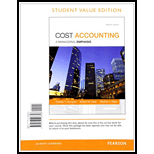
ABC, cost hierarchy, service. (CMA, adapted) Vineyard Test Laboratories does heat testing (HT) and stress testing (ST) on materials and operates at capacity. Under its current simple costing system, Vineyard aggregates all operating costs of $1,190,000 into a single overhead cost pool. Vineyard calculates a rate per test-hour of $17 ($1, 190, 000 ÷ 70, 000 total test-hours). HT uses 40,000 test-hours, and ST uses 30,000 test-hours. Gary Celeste, Vineyard’s controller, believes that there is enough variation in test procedures and cost structures to establish separate costing and billing rates for HT and ST. The market for test services is becoming competitive. Without this information, any miscosting and mispricing of its services could cause Vineyard to lose business. Celeste divides Vineyard’s costs into four activity-cost categories.
- a. Direct-labor costs, $146,000. These costs can be directly traced to HT, $100,000, and ST, $46,000.
- b. Equipment-related costs (rent, maintenance, energy, and so on), $350,000. These costs are allocated to HT and ST on the basis of test-hours.
- c. Setup costs, $430.000. These costs are allocated to HT and ST on the basis of the number of setup-hours required. HT requires 13,600 setup-hours, and ST requires 3,600 setup-hours.
- d. Costs of designing tests, $264,000. These costs are allocated to HT and ST on the basis of the time required for designing the tests. HT requires 3,000 hours, and ST requires 1,400 hours.
- 1. Classify each activity cost as output unit–level, batch-level, product- or service-sustaining, or facility-sustaining. Explain each answer.
Required
- 2. Calculate the cost per test-hour for HT and ST. Explain briefly the reasons why these numbers differ from the $17 per test-hour that Vineyard calculated using its simple costing system.
- 3. Explain the accuracy of the product costs calculated using the simple costing system and the ABC system. How might Vineyard’s management use the cost hierarchy and ABC information to better manage its business?
Want to see the full answer?
Check out a sample textbook solution
Chapter 5 Solutions
Cost Accounting, Student Value Edition Plus MyAccountingLab with Pearson eText -- Access Card Package (15th Edition)
- Mason (single) is a 50 percent shareholder in Angels Corporation (an S Corporation). Mason receives a $184,500 salary working full time for Angels Corporation. Angels Corporation reported $418,000 of taxable business income for the year. Before considering his business income allocation from Angels and the self-employment tax deduction (if any), Mason's adjusted gross income is $184,500 (all salary from Angels Corporation). Mason claims $59,000 in itemized deductions. Answer the following questions for Mason. c. b. Assuming the business income allocated to Mason is income from a specified service trade or business, except that Angels Corporation reported $168,000 of taxable business income for the year. What is Mason's deduction for qualified business income? Ignore the wage-based limitation when computing the deduction.arrow_forwardPlease give me true answer this financial accounting questionarrow_forwardWhat is the price earnings ratio on these financial accounting question?arrow_forward
- Provide answer this financial accounting questionarrow_forwardRembrandt Sports Inc. Providees the following inventory information: please answer this financial accounting questionarrow_forwardWhat is the carrying amount of the trademark on 30 June 2024 for this financial accounting question?arrow_forward
- Principles of Accounting Volume 2AccountingISBN:9781947172609Author:OpenStaxPublisher:OpenStax College
 Cornerstones of Cost Management (Cornerstones Ser...AccountingISBN:9781305970663Author:Don R. Hansen, Maryanne M. MowenPublisher:Cengage Learning
Cornerstones of Cost Management (Cornerstones Ser...AccountingISBN:9781305970663Author:Don R. Hansen, Maryanne M. MowenPublisher:Cengage Learning

